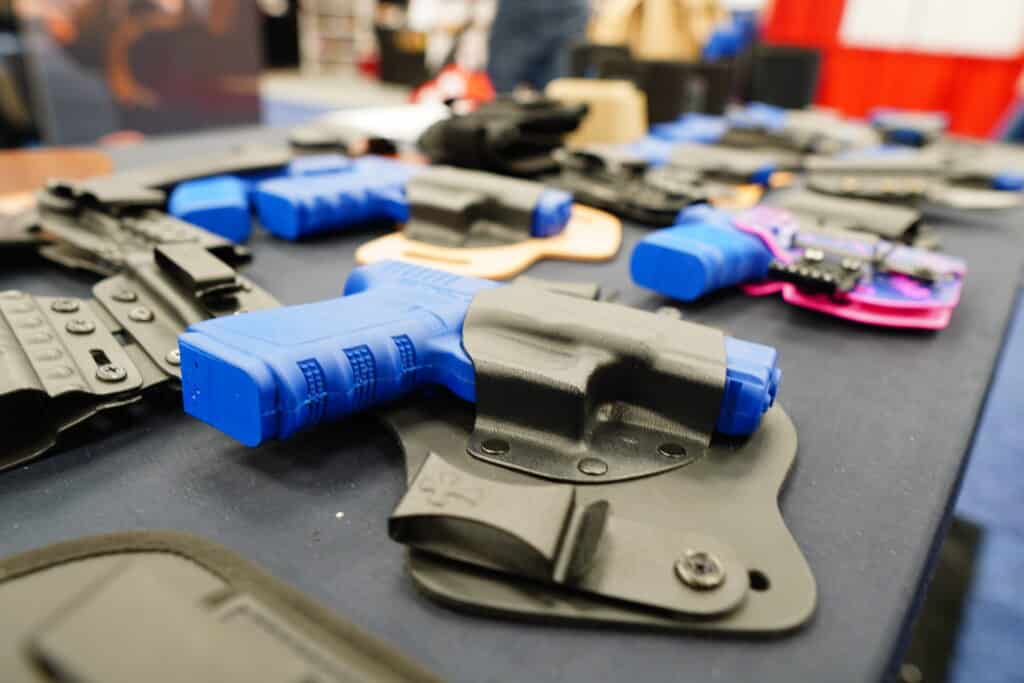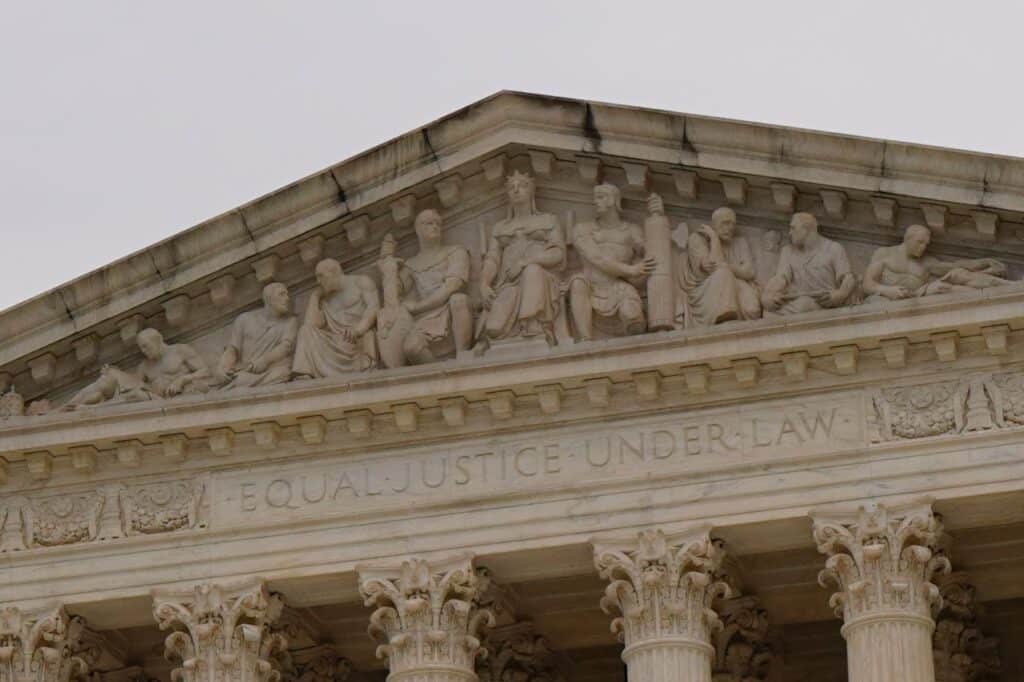Louisiana is about to become the 28th state to adopt permitless concealed carry. That’s an incredible feat considering there was only one permitless carry state 25 years ago. But it also raises the question of how much longer gun-rights advocates can keep up that pace of change.
Contributing Writer Jake Fogleman explains why the answer is: probably not long. In fact, many of the potential target states are moving in the opposite direction.
The Supreme Court also heard oral arguments in Cargill v. Garland, the case against the ATF’s bump stock ban. Unlike the recent hearing in United States v. Rahimi, the case against the domestic violence restraining order gun ban, a consensus was difficult to discern. But, I did my best to highlight and interpret the questions asked by each justice.
Plus, NRA whistle-blower Phil Journey joins the podcast to give his take on the corruption verdict and the group’s future.

Analysis: Permitless Concealed Carry Cap is Fast Approaching [Member Exclusive]
By Jake Fogleman
Gun-rights advocates have had astonishing success in popularizing permitless gun-carry around the country. But the hurdles to adding new states will soon become much higher.
Louisiana became the latest to join the ranks of states to do away with permitting requirements for concealed carry this week when its legislature officially passed Senate Bill 1. The measure will allow any adult eligible to own a handgun to carry it concealed in public without a permit. Louisiana Governor Jeff Landry (R.) has already pledged to sign the measure into law.
Once he does, the permitless carry count will officially stand at 28 states.
That’s a big win for gun-rights advocates at the end of a long road. But the tally is unlikely to tick up much higher than that, at least not for the foreseeable future.
The momentum permitless carry has enjoyed will soon become a victim of its own success. Over the last 25 years, the policy has spread through Republican-dominated states like wildfire–so much so that there simply aren’t many Republican-controlled states left to go.
Outside Louisiana, there remains just one other trifecta Republican state—South Carolina—that does not already have permitless carry enacted into law. And it, too, could soon join the 28 others this year. Republican lawmakers in the state’s two legislative chambers are currently trying to work out a compromise between the two versions of permitless carry that have already passed the state House and Senate.
Looking elsewhere, North Carolina could offer gun-rights advocates some potential. Republicans currently hold supermajorities in both the state’s House and Senate, which they used last year to override a gubernatorial veto on a repeal of the state’s permit-to-purchase regime for handguns. However, lawmakers have thus far been unwilling to expend similar political capital in pushing through a permitless carry measure.
North Carolina’s Democratic Governor Roy Cooper is term-limited this year, which means Republicans will have a decent shot at retaking trifecta control of the state’s government for the first time since 2016 in the upcoming November elections. A 30th permitless carry state would become much more likely under that scenario, though it is far from certain that Republicans will be able to take back the governor’s mansion.
Beyond that, it isn’t easy to see where else the policy could feasibly go. Assuming the political developments in the Carolinas go gun-rights advocates’ way, that would still leave 20 states with divided or solidly Democratic governments where permitless carry does not stand a chance under present-day political conditions.
That leaves two choices for permitless carry activists looking for opportunities to further the policy’s growth in the near term: litigation or political and cultural persuasion.
In 1903, a legal challenge to a local ordinance in Vermont requiring individuals to obtain permission to carry weapons reached the state’s Supreme Court, which ultimately held that it was “inconsistent with and repugnant to” the state’s constitution. Since then, the state has not required, nor has it even offered, carry permits. For 100 years, it was the only permitless carry state in the nation.
It remains the only one by common law rather than state statute.
Barring a similar judicial reading of a state constitutional arms guarantee, however, it seems far-fetched that modern-day challenges to state permitting laws would result in a similar outcome.
It’s also unlikely that federal litigation will bear much fruit for permitless carry activists. Though it’s an open question whether permitting comports with the text, history, and tradition test articulated by the Supreme Court for Second Amendment cases, key members of the Court notably went out of their way to give their blessing to shall-issue carry permits in the New York State Rifle and Pistol Association v. Bruen decision just two years ago.
That just leaves cultural change as the other alternative. Indeed, the previous trend in gun-carry liberalization, the shall-issue revolution that predominately began with Florida’s adoption of the policy in 1987, could point the way forward.
In that case, clusters of states began adopting shall-issue permitting in sporadic waves over multiple decades before it became the country’s dominant policy. It took hesitant states without a traditional culture of concealed carry time to accept that the practice could be adopted without dramatic public safety consequences. Ultimately, all but six got on board by 2022 before the Supreme Court forced the remaining six holdouts to follow suit in Bruen.
Perhaps if permitless carry can demonstrate lasting success without leading to obvious negative externalities in the states where it’s currently on the books, gun-rights advocates can push for a trajectory similar to shall-issue’s spread in the remaining 20 or so states.
At the same time, the political culture surrounding guns has only become more polarized along party lines since the onset of the shall-issue revolution. There are simply far fewer pro-gun Democrats than there were a generation ago. Gun-control activists have become a much more powerful coalition partner for the party in our current climate. So much so that even long-time shall-issue states under Democratic control are starting to backtrack and increase gun-carry restrictions. That makes the task ahead for gun-rights advocates all the more difficult in blue states, especially as they’ve also become increasingly committed to the Republican party.
Gun-rights advocates have had remarkable success in taking permitless carry from a single-state idiosyncrasy to a mainstream policy over the last generation. But barring a serious cultural shift or unexpected judicial ruling, they may have to settle for success in sixty percent of states. At least, for now.
Come on the Podcast
Did you know one perk of your Reload Membership is the chance to come on the podcast? I love interviewing members and getting to know our community here a bit better. Just reply to this email, and we’ll work out a time!
Podcast: NRA Whistle-Blower on the Group’s Corruption Verdict, Path Forward
By Stephen Gutowski
Last week, a jury found the NRA did not safeguard its charitable fund or those who raised concerns about how they were being spent on former CEO Wayne LaPierre’s lavish personal expenses. This week, we have one of those whistle-blowers on the show to give his view of the verdict as well as the group’s future.
Former NRA board member Judge Phillip Journey was among the eight insiders the jury said didn’t receive protection when he spoke out about the group’s mismanagement. He said the jury came to the correct conclusion. And he argued Judge Joel Cohen should appoint a monitor to make sure corruption is rooted out of the organization for good.
Journey said he was sympathetic toward criticism of New York Attorney General Letitia James’s (D.) political motivations. But he also said he had no choice in testifying at the trial, and the facts of the case were plainly against the NRA’s current and former leadership.
He argued drastic change is necessary for the NRA to survive and return to form. He explained the platform he and three other board candidates are running on in the current NRA election. Journey said he hopes the verdict and LaPierre’s resignation will convince many current board members to join the reform effort, but acknowledged he hasn’t gotten very far to this point and it’s likely to remain an uphill internal fight.
Plus, Contributing Writer Jake Fogleman and I dissect oral arguments in the Supreme Court’s bump stock ban case. We also go through the gun news of the week in our headlines section.
You can listen to the show on your favorite podcasting app or by clicking here. Video of the episode is available on our YouTube channel. Reload Members get access on Sunday, as always. The episode goes public on Monday.

Analysis: Where Will the Supreme Court Come Down on Bump Stocks? [Member Exclusive]
By Stephen Gutowski
Oral arguments in Cargill v. Garland concluded on Wednesday without a concrete majority emerging, but there are some clues on where each justice might stand on the ATF’s bump stock ban.
The ban, instituted at the request of former President Donald Trump in the wake of the 2017 Las Vegas shooting, has experienced an uneven ride in the lower courts. It has been upheld by some and struck down by others. Cargill’s challenge won in the Fifth Circuit back in January 2023, but only after losing at the district court level.
So, it’s perhaps unsurprising the Supreme Court hearing didn’t produce the sort of tea leaves that are easy to read.
That doesn’t mean there wasn’t any agreement. Certainly, the entire Court seemed intently interested in how exactly bump stocks work and what exactly “function of the trigger” means in the National Firearms Act (NFA) of 1934. Which makes a lot of sense since the fit–or lack thereof–between the two is likely going to determine the outcome of the case.
Does attaching a bump stock to a semi-automatic rifle convert it into something capable of “automatically” firing more than one shot with a single “function of the trigger”? The ATF said it didn’t for a long time, then they were found among the arsenal of the Las Vegas shooter after he carried out the worst mass shooting in American history, and the ATF changed its mind on the matter. The justices were much more focused on which was the correct interpretation rather than the change itself.
The liberal members of the Court seemed fairly easy to read on that question. Questions from Justices Sonya Sotomayor and Kentaji Brown Jackson seemed to imply they were pretty well convinced the language either literally covers bump stocks or that they should be covered under the intent of the statute. Justice Elena Kagan admitted “there might be some ambiguity,” but still appeared to conclude bump stocks aren’t really any different than other devices covered by the NFA.
“In all kinds of ways, you are accepting of that and saying yes, you can circumvent it by that,” she told Cargill’s counsel. “You can’t circumvent it by non-conventional triggers. You can’t circumvent it by, you know, all these things that — these hypotheticals I’ve been giving you, but you can circumvent it through this one mechanism.”
The conservatives didn’t seem as united on the core question.
Chief Justice John Roberts’ questions focused exclusively on how bump stocks work. He asked whether the shooter had to apply continuous pressure to operate a rifle with a bump stock or if the firing process required them to move their support hand back and forth. But those questions didn’t provide much insight into who he thought had the most credible explanation or what that might mean for the case.
The questions from Justice Clarence Thomas could be read as supportive of either side. He asked the government why the Court should see a difference between bump firing with or without a bump stock since the trigger is used the same way in either case. But he also asked Cargill’s lawyer why, given a bump stock helps the shooter achieve a much higher rate of fire, the device doesn’t fit into the machine gun ban.
“I think the difference is that there may be some who believe — when — when you look at it, the nature of the firing has changed as a result of the bump stock,” Thomas said. “So, if that’s changed, why don’t you simply then look backwards and say that the nature of the firing mechanism has changed; thus, the nature of the trigger has changed?”
Justice Samuel Alito took a similar track. He asked the government why the idea that a single function of the trigger is when it releases “the hammer from the sear so that the hammer can swing forward and strike” isn’t the “most straightforward interpretation” of the statute. However, he also asked the defense whether there was any conceivable reason bump stocks shouldn’t be considered effectively the same as what Congress meant to ban.
“Can you imagine a legislator thinking we should ban machineguns, but we should not ban bump stocks? Is there any reason why a legislator might reach that judgment?” he asked.
The lawyers representing each side had answers to each of these questions, of course. But there wasn’t much indication from the justices which of them they were persuaded by, and we almost certainly won’t find out until the decision is released. How the majority of those three break will determine if the ATF rule stands or falls.
That’s because Justices Neil Gorsuch and Amy Coney Barrett appeared to be the most skeptical of the government’s position in the case. Like Alito, Gorsuch argued grammar dictates that a function of the trigger is when ” the thing itself, [is] moved once.” He also criticized the less strenuous legal process the ATF used to implement its rule. Barrett focused most of her questioning on why the government saw a distinction between bump stocks and other things, such as rubber bands and belt loops, that can also be used to achieve bump firing.
And, while they both said they could understand why bump stocks should be banned, they appeared unconvinced the NFA actually restricted them.
“I can certainly understand why these items should be made illegal, but we’re dealing with a statute that was enacted in the 1930s, and through many administrations, the government took the position that these bump stocks are not machineguns,” Gorsuch said.
Although, he also asked whether the Court should be swayed by the way a semi-automatic rifle can mimic a machine gun’s rate of fire by using a bump stock. And Barrett asked if the defense could still win even if she disagreed with them that bump stocks cause a gun to function “automatically.” So, all the conservatives asked at least some questions that challenged Cargill’s lawyer.
The conservative justices also took some interest in areas beyond the specific functioning of bump stocks and the technical NFA definition of machine guns. The aforementioned ATF flip-flop on the legality of bump stocks came up a couple of times. Alito, Kavanaugh, and Gorsuch questioned the legal jeopardy the ATF’s rule had thrust potentially hundreds of thousands of Americans into. Alito implied it was “disturbing” that people could be prosecuted under the rule even though a lower court had found it unlawful. Kavanaugh criticized the idea prosecution wouldn’t require bump stock owners to be aware they had what the ATF now considers unregistered machine guns. Gorsuch mocked the government’s argument it had done enough to inform people of its changing interpretation of the devices by publishing it in the federal registrar.
It’s possible, though probably unlikely, the Court could find a majority that objects to the rule on those grounds instead of the definitional issue. But it’s much more likely whichever side gets five votes on whether bump stocks convert semi-automatic rifles into guns that automatically fire more than one round per function of the trigger will win. Most of the Court seems pretty uncomfortable that bump-stock-equipped guns can fire so fast, but it appears there may be enough of them who believe the NFA’s text doesn’t currently cover them, and it is Congress, not the ATF, who needs to expand the definition.
That’s it for now.
I’ll talk to you all again soon.
Thanks,
Stephen Gutowski
Founder
The Reload







